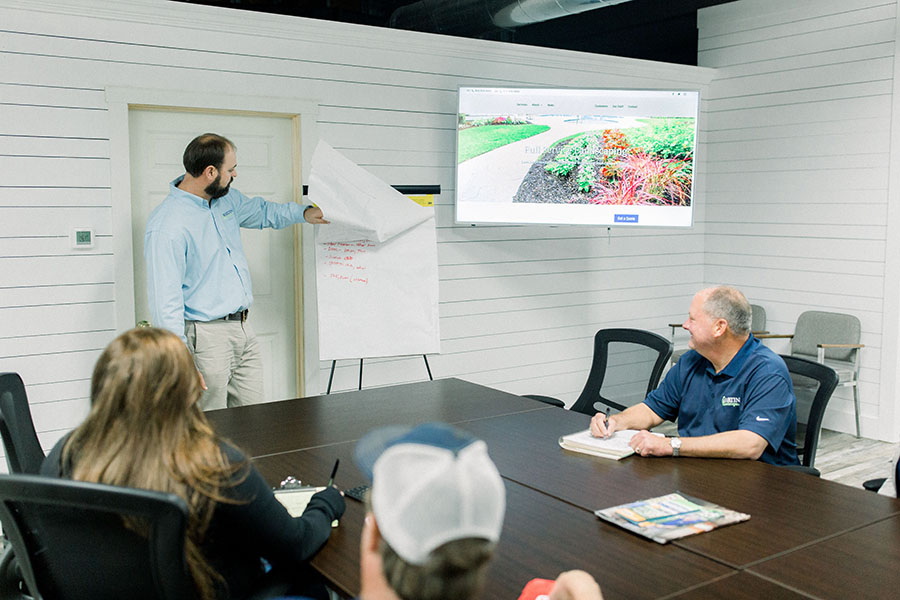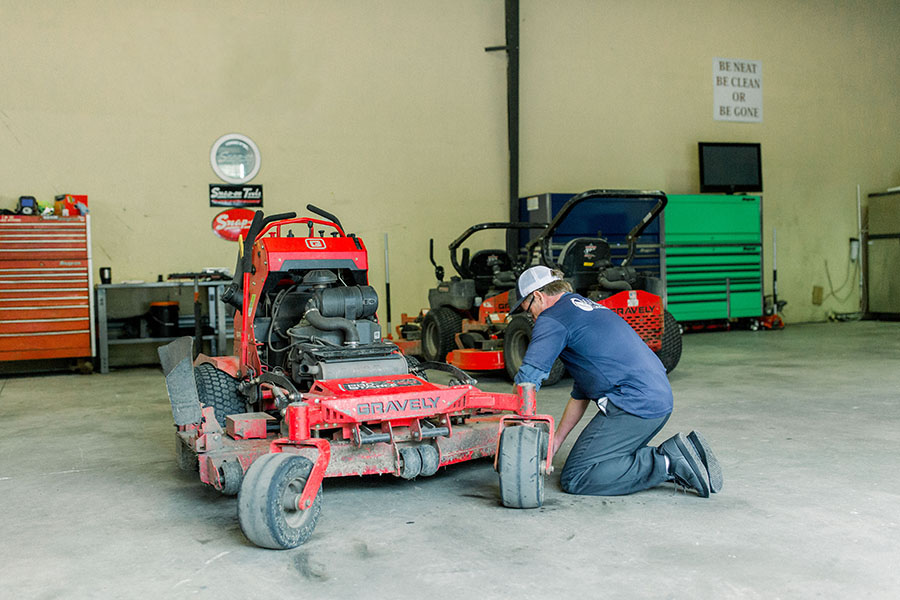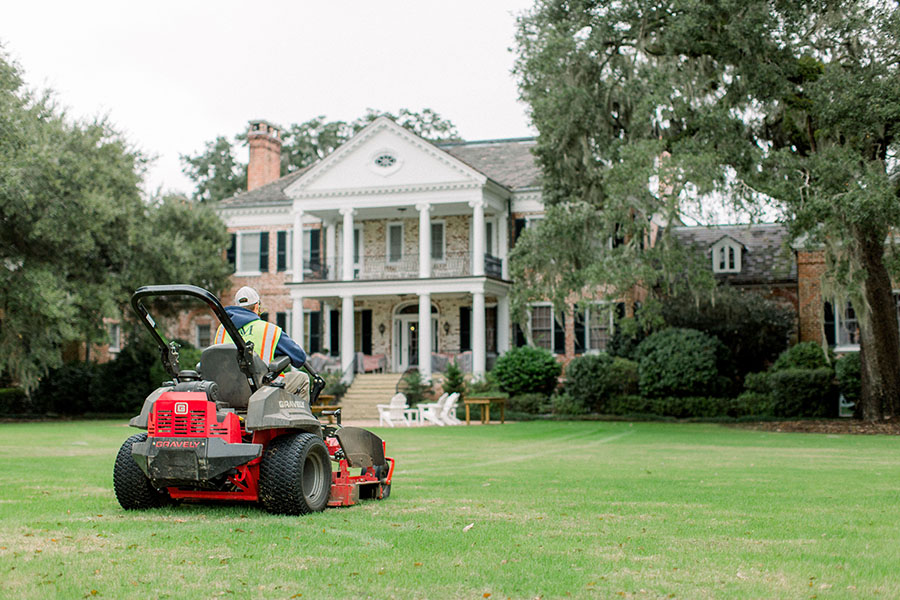Happy Holidays! Our Customer Support will be closed Dec. 24–26 for Christmas & Dec. 31–Jan. 2 for the New Year.
How to Start a Landscaping Business
Visualize your goals
Where do you want your business to be after the first 12 months? What about in the next five years? How do you grow a landscaping business?
According to landscaping industry expert Marty Grunder of the Grow Group, starting a successful business, landscaping or otherwise, needs to start with a vision of the big picture. What do you want your business to achieve and how are you going to make it grow beyond client acquisition? What are you going to do to nurture your existing client relationships and continue to offer more innovative and better level of service (that doesn't necessarily mean more services) to not only retain them, but to also turn them into an advocate for your brand / business?
Your level of service depends on the infrastructure of your business. Plan how you're going to sustain that business through practices like employee onboarding, effective company management and leadership, building operational efficiencies – and overall, continuous improvement.
How to market a landscape business
Put on your walking shoes and hit the pavement.
The beginning is the hardest part, but as long as you put your nose to the grindstone, your blood, sweat and tears pay off. It's an investment that Blake Hawthorn, one of the 2019 Gravely Ambassadors, knows well because he's been there. Since starting his landscaping business in 2011, his formula for success has been a mix of personal relationships, guerilla marketing and establishing a reputation and foothold in certain neighborhoods. He's been so successful that he expanded his customer base from 80 clients to 300 in just three years.
Starting out, Hawthorn would literally go door-to-door in areas he identified as opportunities for his business, which were mostly suburban neighborhoods with new development. While servicing neighborhoods of existing clients, he used a tactic known as "clover-leafing," which is placing door hangers on the homes of neighboring properties while simultaneously looking for opportunities to connect with potential new clients.
Additionally, Hawthorn looked for opportunities to blow off driveways, trim shrubs, haul brush, or even cut whole lawns for free. For those who agreed, which most did, he followed up with them after the job was complete with an estimate for monthly services they could take advantage of if they liked his work. Most of the time, this strategy turned into callbacks. His investment in neighborhood canvassing and a few freebies went a long way in establishing a large clientele, fast.
Follow Blake and learn more of his business insights at @itsHISturf on Instagram and on the it's HIS turf YouTube channel.
Building personal relationships with clients
Do you know that some of the dealer relationships at AriensCo were started with a handwritten letter?
It may be surprising, but even in 2019, the AriensCo inside sales staff still writes personal letters and sends handwritten cards to dealers. While that may seem primitive in a world where emails and phone calls are more efficient, it's 100 percent worth the effort because it leads to strong relationships and favorable business. Handwritten letters and notes are valued because the personalized attention that goes into those tokens build trust in business partnerships.
Leverage a CRM tool to keep track of when it's time to send personalized follow-ups and thank you cards with all of your clients. Remember, the personalization and authenticity of a handwritten letter and signature in ink builds trust and appreciation. If you don't know what a CRM is, look forward to our upcoming blog post highlighting the use of digital tools to grow your business.
Additionally, use this communication opportunity to not only thank your client or follow-up with them, but to ask something of them. For example, ask them to share the experience of their services with their friends and neighbors, ask them to like your social media pages and ask them to write a review of your services online. Again, more to come on those digital tools in our next post.
How to have a profitable landscape business
How much money do you want to keep each year? Really the choice is yours, but you need to crunch the numbers to make that decision.

Entrepreneur Media Inc. published a book called Start your Own Lawn Care or Landscaping Business. Couldn't have hit the nail squarer on the head to this blog topic, huh? According to an excerpt from that book, landscape contractors should define a baseline to their service prices based on a calculation of their entire annual overhead. Overhead meaning equipment, gasoline, labor, parts, contracted services, miscellaneous expenses, etc. Crunch the numbers of the total annual cost of your business operation. Divide that amount by 12, then divide that number by the average hours spent on all jobsites in a month. Presto, the quotient is the baseline, minimum rate you should charge for each hour on a jobsite.
But of course, you're working for more than experience and you need to eat, which is why you need to calculate profit into each hour spent on a jobsite. So, once again, turn to the calculator and start with the annual profit you wish to make. Say that's $40,000.00 per year. Divided by 12, that's $3,333.33 per month. Divided by the number of average hours on all jobsites in a month (let's say 160 hours), you get $20.83 that needs to be added to your hourly rate. Remember, hourly rates do not include cost of materials like mulch, plants and other things needed only for certain jobsites. Additional material costs should be added to the bill separate from the service charge.
Though profit is up to you, you can't just pull that number out of a hat. Maybe you want $100,000 of profit per year? That's fine, but you have to consider how your hourly rate with that profit calculation compares to the rate of your competition and the market of your service offering. Can those variables sustain your goal?
How to charge landscape clients
The most important thing to do is be up-front with clients with your charges so they aren't surprised when they get the bill. People don't like making expenses that weren't accounted for.
The standard in many industries, including the landscaping industry, is to offer a free consultation to new or prospective clients. The consultation is a physical survey of a client's landscape to determine how many hours it will take to work that jobsite. That estimate allows you to provide the client with an honest, accurate cost for each visit to their property, which is all dependent on the services they receive.
Remember, the price quote isn't an estimation. The number given to a client is the charge they expect to see on future invoices for your services and it's the charge you're going to honor for the contract period. Just don't confuse this with the hourly rate. Keep the hourly rate to yourself and only present the final cost in the customer's invoice.
Finally, define a contract period so that as your expenses increase, as they may with the growth of your business and inflation, you can update your hourly rate to account for those increases. Lock in the customer at the same price for that contract term, let's say 12 months, so the customer is assured they'll pay the same price for a year and so they won't be shocked when you need to increase their bill in a new term. It's like a lease on a rental property. There's a price lock for a year, but when the lease is up for renewal, the price increase is almost expected and rarely protested.
Schedule landscaping services
If possible, establish a routine with your clients and schedule your services on a regular basis.
Schedule recurring service with your clients based on the rate of grass growth in your geographical area during the mowing season. Though grass may not always be ready for a cut at these recurring intervals, once per week, for example, it ensures a steady workload and helps your crews stay organized, manage daily property assignments efficiently and create capacity to expand to more.
Though consistent scheduling will work best for your business, droughts and customers who would prefer service on an as-needed basis will make it impossible to schedule recurring services. You can't schedule or plan for everything, but even scheduling some of the workload will be helpful.
Hiring landscaping employees
Your business started out as a side job with just you, which was easy to manage. Now, your reputation is taking off, your workload is growing and you need help. Unfortunately, it's hard to find good help these days, so how do you source good employees?

Total Landscape Care suggests looking in nontraditional places. One demographic of potential employees that can't seem to get enough work are college students who have energy, can work on a part-time basis and are motivated to pay off loads of student debt as quickly as possible. Additionally, not all students fresh off the graduation stage have careers waiting for them, meaning they'll gladly take full-time hours in the interim, which after the Spring semester, is in early May. Reach out to local colleges and their alumni networks and tell them you're accepting student employees and recent grads who are both looking for part-time work during the semester and full-time hours during summer break. The best part is, the universities will do a lot of the advertising work for you within their own networks.
If you already have quality employees but need to grow, tap into those employees' networks by offering a referral program that rewards them with cash or benefit incentives if they help source a new, quality employee. The reason this is so effective in sourcing quality employees is because the reputation of the current employee is on the line; the performance of a referral is a reflection on the employee who referred them.
Allow the interview process to be a trial. Not only should you have a face-to-face meeting with a prospective new employee, but you need to learn for yourself if they have the right character and skills for the position. Include a field trial as part of the interview process to see how that prospect interacts with others, how their skills hold up to their claims and how they solve problems.
Leverage your social media channels to show the rest of the world what it's like working at Your Landscaping Company. Are you sharing pictures of the jobsite that make the work look appealing and rewarding? You should, because the content on your social media pages are a first impression of your brand.
Best lawn mower brands
You can't build a business with shoddy work, meaning your success as a commercial landscaper requires an investment in quality, American-crafted landscaping equipment from Gravely. Born in Dunbar, West Virginia, in 1916, Benjamin Franklin Gravely built and patented a machine that helped shape the American landscape.
Today, Gravely is still an American lawn mower company and is still addressing the needs of its customers. Gravely products, which are designed, fabricated and assembled by the hardworking, Midwestern American workforce of Brillion, Wisconsin, are build specifically for commercial landscapers that require dependability in the machines that generate their livelihood. Built from high-strength, quality, raw steel, Gravely commercial lawn mowers are built with superior comfort, innovative engineering, dependable power packages and premium style.
Click here to find your nearest Gravely dealer.

